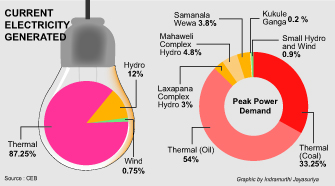News
As drought continues, CEB switches to 88.4 per cent thermal
View(s):The percentage of expensive thermal power generated by the Ceylon Electricity Board (CEB) is rising daily as the Government sticks to its “electricity at any cost” policy despite drought in hydro-catchment areas.
On Friday, a massive 88.4 per cent of the country’s energy requirement was met with thermal power, statistics published by the CEB show. Only 11.3 per cent of hydroelectricity was generated. This is an increase from a week ago when 84 per cent of power was generated by thermal power stations while 15.3 per cent came from hydroelectric power stations.
Despite mounting losses to the CEB, the utility is implementing the Government’s policy of providing uninterrupted power supply. There will be no power cuts, said Senajith Dasanayake, CEB Assistant General Manager.
“In the afternoons, the thermal power stations are on and it’s 90 to 100 per cent thermal,” said Mr. Dasanayake, who is also the CEB’s official spokesman. “During peak hours, between 6 pm and 9 pm, we use all the stations, including the most expensive machines in the system. The water in the reservoirs is being used very sparingly because the priority is for drinking and agriculture.”
He urged the public to save electricity, particularly during peak hours. He also said the CEB does not anticipate an increase in its burden during the National Holidays because shops and industries will be closed, thereby reducing consumption. “The load is less,” he explained
Meanwhile, the second unit of the Lakvijaya Thermal Power Plant at Norochcholai is being tested. On one day this week, both units ran at full load, adding 600 megawatts of power to the grid. There is still no date for its official inauguration as CEB engineers want to ensure all aspects of the complicated unit are tested for weaknesses.
“There are thousands of systems and our engineers are testing each one,” Mr. Dasanayake said. “While the process is ongoing, the power produced is absorbed to the CEB system.” He added that the existing transmission line from Puttalam to Veyangoda is able to carry the full capacity of the two units.
When the third unit is commissioned, however, the new transmission line to Anuradhapura must be made available. It is currently held up due to environmental and social concerns. The CEB incurred heavy losses in the first three months of this year.
“On the cost side, 85 to 95 per cent goes towards the power we are buying from both CEB stations and independent power producers,” Mr. Dasanayake said. “Costs are higher than revenue.
“We have had dry years and wet years,” he explained. “We nearly made a profit in certain months during 2013 which was a wet year. In January and February 2014, we managed to pay back our arrears to the Ceylon Petroleum Corporation and independent power producers from money collected the previous year.”
Mr. Dasanayake also said both machines of Laxapana Hydro Power Station have been shut down to carry out repairs on an underground tunnel taking water between reservoirs and the plants. Each generates 50 megawatts of electricity.
“The underground tunnel had not been inspected for the past 40 years,” he explained. “But since the 80s we knew that there was a leak.” Repairs were postponed several times but the CEB decided to implement the project this year because of the availability of funds under the World Bank funded Dam Safety and Water Resources Planning Project.


